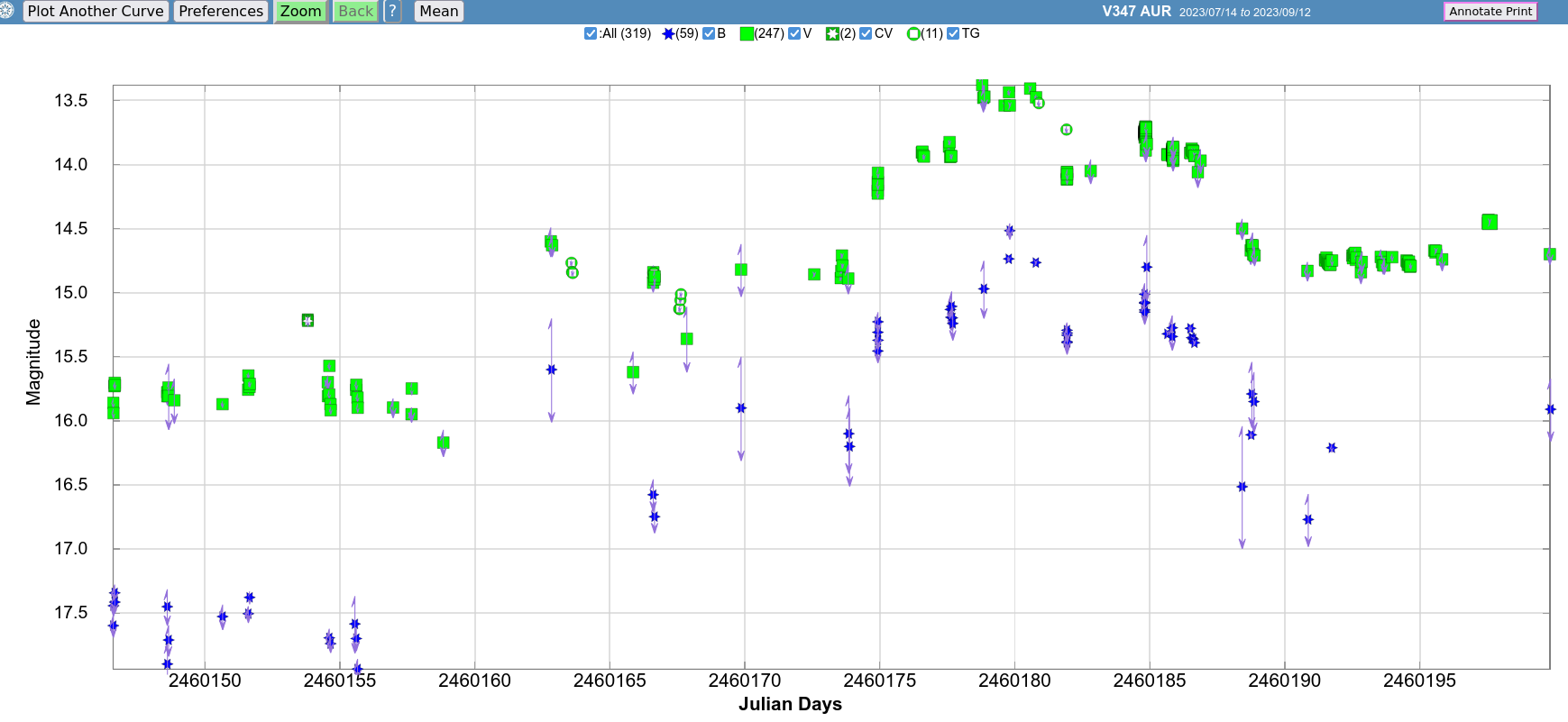
On the night of Sep 11/12, 2023, under good conditions, I acquired images of V347 Aur as part of our optical monitoring program. All data was taken with the 12-inch telescope and ASI camera. Conditions were good, and after I took images of the target, I made a small adjustment to the collimation.
Later in the day of Tues, Sep 12, Michael Cavuto and two other FMS workers came to the Observatory for the annual "lubricate the dome motors" maintenance. They did an excellent job of checking the system and adding grease and/or lubricant where necessary. Thank you!
The variable continues to maintain its plateau brightness.
V347 Aur is a young stellar object (YSO) which undergoes semi-periodic outbursts. I'm part of a team of astronomers who have applied for (and received) time on the XMM-Newton X-ray telescope to study this object in the fall of 2023. We have organized an observing campaign with the AAVSO to monitor the object in the optical in order to determine when the outburst begins -- if it begins! Our prediction is some time in mid-August, 2023.
These observations involved:
Notes from the night:
The position of the variable star is
RA = 04:56:57.02 Dec = +51:30:50.9
At quiesence, it has magnitude V = 16-ish, but can rise to V = 12 in an outburst.
Here's a chart from the DSS2 Red plates, 0.6 degrees on a side.

The picture below, based on a stack of images taken on UT Jul 23, 2023, shows the area in the red box above. The variable is at its quiescent level in this image.

I've marked the location of several comparison stars.
star AAVSO ID B V ------------------------------------------------------ B 140 15.134 14.001 C 127 13.617 12.660 D 154 17.491 15.361 --------------------------------------------------------------------------
Here's a picture of the guider TV when pointed at the field (pointed slightly to the left of the variable, actually).

Tonight's stacks were formed from 22 x 60 sec in V band and 39 x 60 in B band. I used a photometric aperture of 5 pixels (6.0 arcsec).
I reported the following to AAVSO:
JD filter mag
---------------------------------------------------
2460199.82 V 14.70 +/- 0.07
2460199.85 V 15.91 +/- 0.24
---------------------------------------------------
The variable remains on its plateau.

After finishing with V347 Aur, I removed the big ASI camera from the 12-inch's Cass focus and put the video camera in place. I pointed at Mirphak and threw the camera way out of focus, using 10 small turns of the silver knob to the CCW. The out-of-focus PSF initially looked like this:

Let's label the secondary-adjustment screws as "A", "B", and "C", where "A" is 12-o'clock on the North side, "B" is clockwise around 4 o'clock, and "C" is clockwise again about 8 o'clock. I first twisted the "B" screw 1 small unit in the CCW direction.

I then gave the "B" screw another small CCW turn, but this made things a bit worse, I think.

So, I turned the "B" screw back CW a bit, and ended up with this PSF:

That looks better than the initial PSF, so that's good. I didn't put the ASI camera back on the telescope to check the results, so that will have to wait for next time.
Unfortunately, due to the difference in focus position between the ASI and video cameras, I will probably have to use the silver knob to achieve focus on the ASI camera ... which may very well throw the telescope out of collimation again. Sigh.